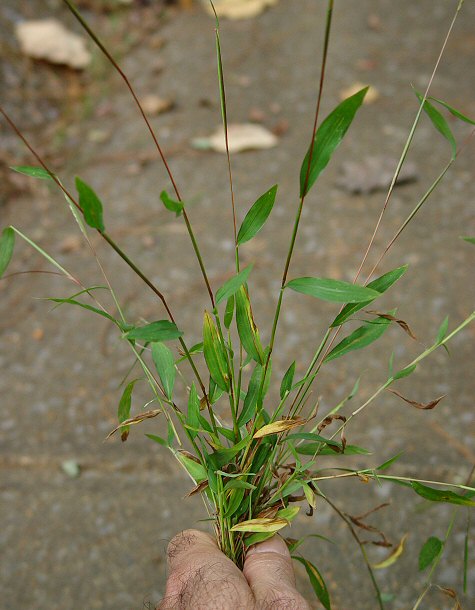Microstegium vimineum (Trin.) A. Camus
Japanese Stiltgrass

Introduced
CC = *
CW = 0
MOC = 18
© DETenaglia
Microstegium vimineum (Trin.) A. CamusJapanese Stiltgrass | |
 |
Introduced CC = * CW = 0 MOC = 18 |
© DETenaglia |
|
Family - Poaceae/Andropogoneae Habit - Annual grass, forming dense colonies.
Stem - Flowering stems to 1 m, spreading to ascending, branched, rooting at the lower nodes, glabrous.
Ligule - Leaf sheaths glabrous or hairy along the margins, rounded on the back, the ligule membranous, the margin hairy.
Leaves - Blades 3-12 cm long, 3-12 mm wide, linear, flat, sparsely hairy.
Inflorescences - Palmate clusters or short panicles of 1-4 spikelike racemes, not enclosed by the leaves. Individual racemes 3-7 cm long, with the axis hairy, breaking apart into joints (as a unit with the associated spikelets) at maturity, the spikelets paired at the nodes.
Spikelets - Stalked and sessile spikelets similar, both perfect, the stalk shorter than the sessile spikelet, flattened, hairy along the edges. Spikelets with the perfect upper floret subtended by a sterile floret, this reduced to a membranous lemma lacking an awn. Glumes 4.5-5.5 mm long, slightly longer than the florets, thin, hairy along the margins. Lowermost glume elliptic-ovate, 2- or 3-nerved, more or less rounded on the back. Upper glume 3-nerved, keeled. Lemmas membranous, narrowly ovate, awnless or the lemma of the fertile floret sometimes with a spirally twisted awn 4-8 mm long. Paleas absent or much shorter than the lemmas. Fruits 2.8-3.0 mm long, elliptic, yellowish brown to reddish brown.
Flowering - September - November. Habitat - Bottomland forests. Origin - Native to Asia. Lookalikes - Broadly, numerous other grasses. Other info. - This introduced weed was first reported from Missouri in 1990, and since then has spread like wildfire. It is a noxious invasive which will readily form vast carpets in moist, shaded bottomlands, outcompeting and choking out nearly every other herbaceous species. Plants are typically a foot or so in height, but in well established populations can reach waist high or above. Along with the general appearance of the plant, the shiny stripe down the center of the upper leaf surface is highly characteristic aid to identification. If you must walk through a patch of this plant, be diligent about cleaning your footwear afterward in order to avoid tracking it into uncontaminated areas. New populations of the plant should be reported to the local park service or Missouri Deparment of Conservation; however, in the long run it will probably be impossible to arrest the plant's spread without the aid of specific eradication policy or technology. Photographs taken at Lake Guntersville State Park, AL., 10-16-04 (DETenaglia); also at Greensfelder Park, near Pacific, St. Louis County, MO, 10-13-2016 (SRTurner). |